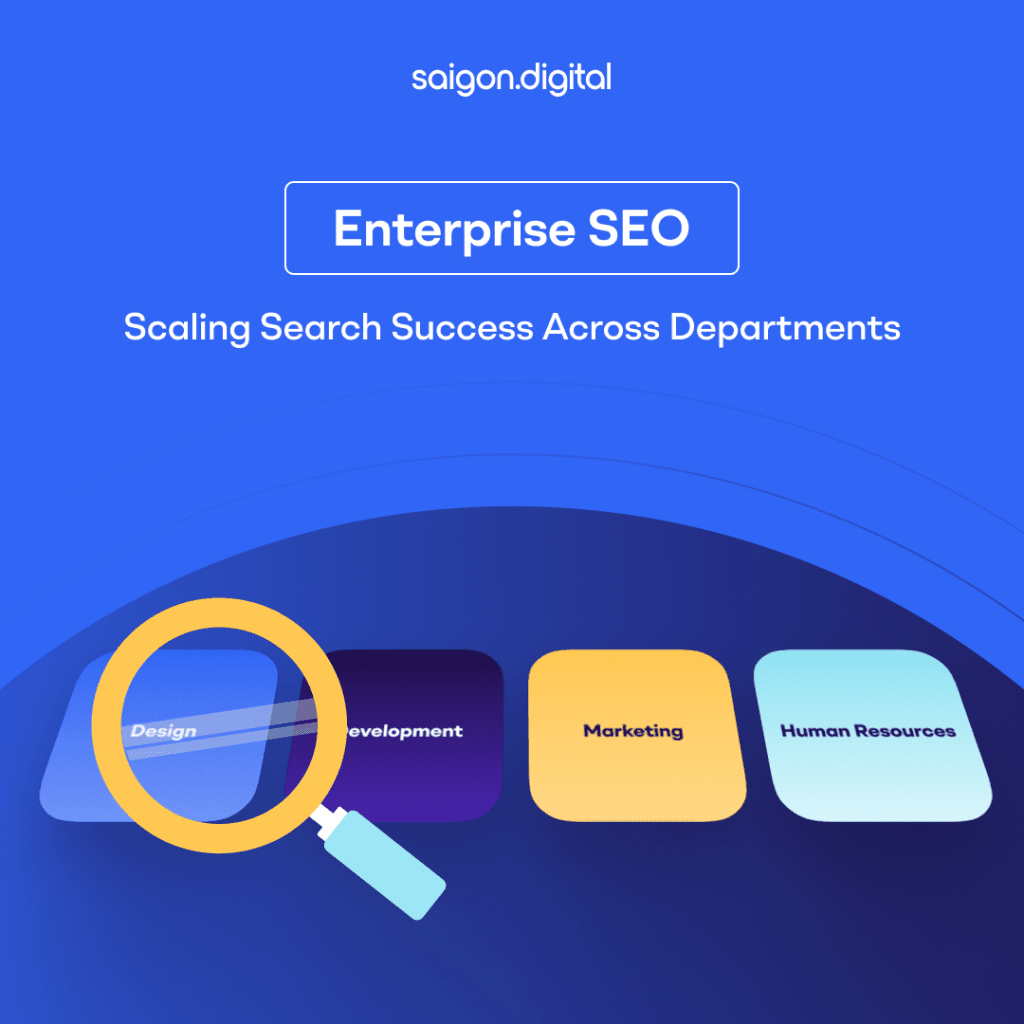
What is Enterprise SEO?
Enterprise SEO is the process of applying search engine optimisation practices to websites that are large in scale and complex in structure, often managed by organisations with significant digital presence and multiple business units. These websites can include thousands, or even millions, of pages, product listings, blog articles, service descriptions, and location-based microsites. But size alone doesn't define enterprise SEO. It also refers to the strategic integration of SEO across teams and departments, ensuring that search visibility is embedded into the organisation’s digital DNA. Core Components of Enterprise SEO:- Site architecture management: Maintaining a scalable, crawlable structure as the website grows.
- Technical SEO at scale: Addressing issues such as duplicate content, indexing inefficiencies, and crawl budget allocation.
- Cross-team coordination: Involving marketing, development, product, legal, and UX teams in SEO workflows.
- Brand and content governance: Ensuring every piece of content follows SEO best practices while remaining on-brand.
- Automation and workflow tools: Using enterprise-grade platforms to manage SEO tasks across thousands of pages.
- International and local SEO strategy: Optimising for different languages, regions, or store locations.
Why Enterprise SEO Matters
The value of enterprise SEO extends well beyond just higher rankings on Google. For large organisations, it serves as a strategic growth lever, influencing everything from lead generation and ecommerce sales to brand trust and market share. Let’s explore the key reasons why enterprise SEO is mission-critical.Scalability Equals Visibility
In enterprise environments, marketing activities are rarely one-off campaigns. The ability to scale content creation, optimisation, and distribution is paramount. SEO needs to work not just for one blog post or one product page, but across thousands. Without an enterprise SEO strategy , organisations risk content duplication, internal competition (cannibalisation), and missed opportunities to rank for valuable keywords. A scalable SEO process ensures that each content piece, whether created in New York or Vietnam, adheres to a consistent framework for success. Example: Imagine a fashion retailer like ASOS launching hundreds of new seasonal product pages each quarter. Without scalable SEO guidelines and automation, those pages may go unindexed or underperform in search due to inconsistent meta tags, thin content, or broken internal links.Brand Protection and Governance
Large websites often have multiple content creators, editors, and web managers. This decentralised approach increases the risk of brand inconsistency and SEO mistakes, such as publishing duplicate content, ignoring canonical tags, or using misleading product descriptions. Enterprise SEO includes governance policies and templates that enforce consistency across metadata, content tone, structured data, and user experience. This protects the brand while ensuring compliance with both search engine guidelines and internal standards. Example: A global healthcare company with separate teams managing different countries’ websites must ensure all medical claims, schema markups, and on-page language are both locally accurate and SEO-friendly.Revenue and ROI
SEO remains one of the highest ROI digital channels, especially over the long term. Organic traffic tends to have lower customer acquisition costs and higher conversion rates compared to paid search or display advertising. For enterprise ecommerce sites or B2B SaaS companies, even small improvements in visibility for high-intent keywords can equate to millions in additional revenue. Enterprise SEO, when measured against lifetime customer value, can outperform short-term paid media tactics. Example: A SaaS platform ranking #1 for “project management software for enterprises” might receive thousands of highly targeted leads monthly without spending on ads, resulting in sustainable pipeline growth.Silo-Busting for Strategic Growth
One of the biggest barriers to SEO success in large organisations is the existence of departmental silos. SEO needs content from marketing, buy-in from development, compliance approval from legal, and support from product teams. Enterprise SEO encourages cross-functional collaboration by positioning search optimisation as a shared responsibility, not just a marketing task. When SEO is built into the product roadmap, content creation workflows, and compliance checks, growth becomes systemic.Enterprise SEO vs Traditional SEO: What’s the Difference?
To the untrained eye, all SEO might look the same. However, there are significant differences between traditional SEO for small or mid-sized businesses and enterprise SEO for large-scale organisations. Traditional SEO Enterprise SEO 100–1,000 page websites 10,000+ page websites Managed by individuals or small teams Involves multiple departments Manual content updates Requires automated workflows Local, niche keyword targeting Global, multi-language strategy Shorter approval and execution cycles Longer lead times, compliance reviews SEO managed by a single team SEO embedded across teams This scale and complexity require a process-driven approach, with clear documentation, systems integration, and stakeholder alignment.Scaling SEO Across Departments: A Cross-Functional Approach
True enterprise SEO success comes when it's treated not just as a marketing channel but as a strategic function embedded across departments. Here’s how various teams play a role:Marketing and Content Teams
These teams are the engine of visibility. Their responsibilities include:- Keyword strategy development: Targeting informational, navigational, and transactional queries.
- Topic clustering and pillar pages: Structuring content to build authority on core topics.
- Optimising existing content: Refreshing outdated articles and consolidating underperforming pages.
- Content calendar integration: Syncing SEO objectives with editorial timelines.
Web Development and IT
Technical teams are the gatekeepers of a site’s crawlability, performance, and indexation. Key contributions include:- Page speed optimisation: Leveraging caching, image compression, and code minification.
- Mobile-first implementation: Ensuring responsive design and mobile usability.
- Structured data deployment: Using schema.org to enhance search appearance.
- Log file analysis: Monitoring how search engine bots interact with site infrastructure.
Legal and Compliance
Especially in regulated industries (finance, healthcare, education), legal plays a pivotal role:- Reviewing on-page language: Ensuring accuracy and compliance with regulatory standards.
- Handling GDPR and cookie policies: Avoiding penalties by implementing privacy measures correctly.
- Approving claims: Verifying statements and stats used in SEO copy.
UX and Product Teams
Search engines reward not only content relevance but also user satisfaction and engagement. Product and UX teams can:- Improve navigation: Making key sections easy to reach via breadcrumbs and menus.
- Reduce bounce rate: Designing pages that are informative, fast-loading, and easy to use.
- Boost internal linking: Connecting relevant pages to support crawlability and user discovery.
Enterprise SEO Tools and Technologies
Given the scale of most enterprise websites, manual SEO is no longer sufficient. Enterprise SEO demands powerful SEO tools and platforms that provide automation, reporting, workflow management, and customisation. Top Tools for Enterprise SEO:- BrightEdge / Conductor: Platforms that track keyword performance, provide content recommendations, and integrate with CMS systems.
- Screaming Frog: Essential for large-scale crawling and auditing of technical SEO issues.
- Botify: Helps analyse log files, crawl patterns, and indexing challenges at scale.
- SEMrush / Ahrefs: For tracking competitors, finding backlink opportunities, and discovering content gaps.
- Clearscope / Surfer SEO: Supports content teams with semantic keyword suggestions and optimisation scoring.
- Looker Studio + BigQuery: Ideal for creating dashboards and visualising enterprise SEO data.
Best Practices for Enterprise SEO Success
To maintain momentum, organisations should adopt the following enterprise SEO best practices:1. Create an SEO Governance Framework
Develop standard operating procedures (SOPs) that define:- Meta tag conventions
- URL structure
- Image optimisation standards
- Redirect policies
- Internal linking rules
2. Invest in SEO Training for All Departments
Hold regular training sessions tailored to different teams:- Content creators learn how to write SEO-optimised copy.
- Developers learn how to avoid rendering issues.
- Legal/compliance understand the balance between accuracy and optimisation.
3. Implement Shared Workflows
Use project management tools (like Asana, Jira, or Monday.com) to:- Track SEO-related tasks
- Assign responsibilities
- Collaborate across departments
4. Audit Technical SEO Regularly
Perform monthly or quarterly audits to address:- Crawl errors
- Duplicate content
- Schema issues
- Mobile and Core Web Vitals performance
5. Use Data to Drive Content Strategy
Leverage Google Search Console, Looker Studio dashboards, and keyword research tools to:- Identify high-opportunity keywords
- Optimise underperforming content
- Find new content angles
- Monitor competitors’ rankings
6. Localise at Scale
For multi-location businesses:- Use hreflang tags for international sites.
- Create local landing pages with unique content.
- Optimise Google Business Profiles per location.





